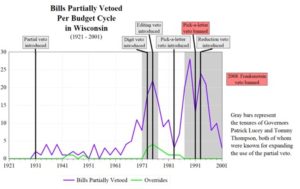
Balance of power in Wisconsin
The partial veto power, even after its reductions in 1990 and 2008, remains a potent tool that is exclusive to Wisconsin. In a 1994 essay in the Marquette Law Review titled “Personal Reflections on the Partial Veto,†former Governor Anthony S. Earl (the pioneer of the now-defunct “pick-a-letter veto”) discussed the “error of his previous ways.â€
Earl recognized the power of the partial veto as not lying within any formal rules:
“…the rules governing the use of the partial veto were clear. The rules were neither based on political philosophy, meaning in accordance with the respective roles of the executive and legislative branches, nor were the rules based on what was legal; the Supreme Court had made clear that a very ambitious use of the partial veto was legal. Rather the rules were based on politics. If a majority (or, more accurately, one-third of the members plus one in either house of the legislature) favored the result occasioned by the use of the partial veto, the result would stand.â€
Earl went on to discuss the policymaking imbalance that the power created:
“At the federal level, with no partial veto authority by the president, there is an imbalance that places too much authority in the hands of the legislature. Congress can and regularly does add to budget bills extraneous items that the president has no ability to delete unless he vetoes the entire measure. Wisconsin is on the other end of the spectrum where the governor, through the use of the partial veto, can actually create laws that were never even considered by the legislature. Neither of these extremes makes for good public policy.â€

Although Earl’s article came before the 2008 constitutional amendment, many feel as though the balance of power complaint remains valid. The partial veto power strengthens the gubernatorial role in the budget process to a degree not seen in other states.
The partial veto is most important when the legislature and the government are the most at odds. As Wisconsin gears up to finish the 2019-21 budget process with a Democratic governor and a Republican legislature, the partial veto is almost certain to enter the political spotlight.
Click here to read Part 1 of this 2 part series on the history of veto power.
Interested in the latest in Wisconsin politics and government?Sign up today!





